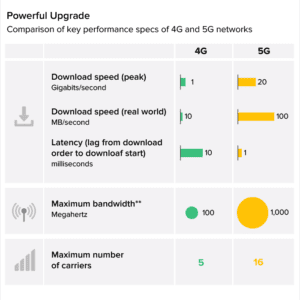8 Mobile Development Trends to Expect in 2021
Mobile apps are the gateways of the times to come. By making services, facilities and utilities at the disposal of the users convenience, they have themselves developed into a realm of dynamics where the business scope of future is now taking shape.
The best part about utilizing mobile apps however is the aspect that they have now reached almost all corners of the world. With lowered internet tariffs and mobile costs, mobile apps have now become the go-to option for all required essential services including education and bank transactions, amongst others.
Technology developments transforming Mobile Apps in 2021
The enlisted mobile app development trends will be further evolving mobile apps functionalities:
5g is going to be here:
The various mobile app functionalities and utilities require transferring of data packets from and to various company servers through internet connections. The speed of transferring of these data packets is thus highly dependent on the prowess of the networks that enable their working.

In this context, the world has been witnessing (amidst the developed countries already) the rise of the 5G era, wherein data shall be transferred at speeds 20 times that of 4g and 4g LTE. With Latency time (time taken by a wireless device to respond to another device) of as low as 1 millisecond and bandwidth increased 10 folds; this technology innovation will enable a host of new services, including connecting new devices and equipment.
An era of overwhelmingly connected devices (IoT)
With internet speed set to multiply many times and bandwidth criteria set to expand, the number of connected devices in the realms of our daily lives is also set to explode in 2021. These connected devices like smart tv’s, smart A.C.’s, Alexa, Google Home, etc. are actually transforming the way things work at our homes and work spaces(IIoT) alike.
As per a research by Cisco, ‘there will be 27.1 billion networked devices in 2021’ and more than 43% of these devices are touted to be mobile connected. The technology is further set to witness mushrooming of several small businesses as well as large enterprises dealing in their software and hardware deployments.
Creating 3D experience with AR and VR
Augmented Reality and Virtual Reality are soon expected to become the choicest options for developing User interfaces and user-experiences globally. With the real-like 3-d effects that they develop on a user created (Virtual Reality) background or a real-time (Augmented Reality) background; they have been helping users to see their technology developed interfaces in a new light of understanding, analysis and usability. AR and VR have thus found imminent usage in the industries of military, gaming, development of car, flight and other simulations; education, retail, amongst others.
Cybersecurity is going to be a huge concern
Most of the money as well as its transactions have now gone digital. With the COVID-19 scenario and Government policy support, usage of digital money through the various payment gateways and UPI’s has been witnessing a phenomenal surge. Growth of hackers, their tools and tactics have also been witnessing a similar surge. The people, businesses and companies thus, dealing online are going to require stronger steps and tools to safeguard users, their devices and data.
Since, no one can afford a cyber-threat or cyber attack nowadays, security for mobile apps is now a growing user and developer concern. Due to these reasons, the global market for cybersecurity software is predicted to grow from $183.2 billion in 2019 to $230 billion in 2021, with a 12% CAGR in the forecast period.
With companies now investing heavily into tools and software to protect their data and users from threats like ransomware, phishing attacks, etc. the trend to even deploy technologies like blockchain to try creating non-hackable platforms and non-hackable network (Deft University has been trying to build an non-hackable internet network, connecting four cities in the Netherlands entirely by means of quantum technology,) is going to be a thing.
M-commerce is changing the way world shops
Mobile apps sales are set to account for more than 54% of all e-commerce sales the world over. Thus, if you are a business with online presence, you need to make your m-commerce presence your first priority in 2021.
The ever-growing usage of smart-phones (the ease of use and accessibility that they offer!), evolving technologies pertaining to user experience, higher reliability of search engines and influential social media platforms have together enabled this technology to grow both in terms of subscribers as well as sales.
Artificial Intelligence shall be further adorned
In 2021, AI will also be used for increasing stakeholder experiences, apart from increasing efficiency and effectiveness of operations for technology-led projects.
Artificial Intelligence is the base technology concept that enables development of smarter systems by analysis, usage and assimilation of eons of data generated by users the world over.
As language and voice-driven intelligence concepts (NLP) take off in the coming times, AI is set to further spread its wings to become the ‘new normal’ in our lives, intelligently empowering developments in robotics, user tracking, automated services, and contactless procedural domains.
Edge computing between networks
As the number of devices networked amidst IoT and other networks explode, management and analysis of data generated through them has been a task. Edge Computing herein enables storage and analysis of this data closer to the source or target (before entering the Clouds) enabling real time computing power closer at hand.
Faster internet options including 5G are now allowing edge computing to accelerate the creation of real-time applications, such as video processing and analytics, self-driving cars, artificial intelligence and robotics, amongst others.
An explosion of Location-based services
The global location-based services market was valued at USD 36.2 billion in 2019. The market is touted to reach USD 126.4 billion by 2025 with an annual growth rate of 23.2%.
Location based services are basically a host of mobile operations and applications based upon the ‘geopositioning system’ (GPS) of the smartphone, that enables the mobile apps and their owner businesses to track user location. For instance: Amazon now offers products and services to users based upon their locations. Even Facebook enables businesses to give ads as per subscriber locations. Mostly, all apps these days use this service in one form or the other.
With GPS technology, businesses can offer much more relevant and user-centric content to their users in a much more natural way to the people they are trying to reach. In a world, where mobile apps are reshaping business platforms, this service can transform the overall outlook of mobile apps.
At the end
Technologies have been defining our lives for a long time The above stated development trends are expected to define mobile app developments in 2021. If you intend to develop a mobile app in the coming times, keep an eye on these technology developments for sure!









